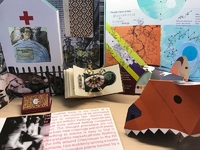Artists' Books Collection
Item set
- Title
- Artists' Books Collection
- Description
- Items from MacEwan University Library.
- Creator
- Blasko, Kathy, Archives Technician
- Date
- 2023-07
- Language
- eng
- Publisher
- MacEwan University Archives
- Subject
- artists' books; conceptual art; printing
- Type
- Collection
Items
-
 This work features photographs of the polluted air of Los Angeles, described as a kind of toxic color-field theory.
This work features photographs of the polluted air of Los Angeles, described as a kind of toxic color-field theory. -
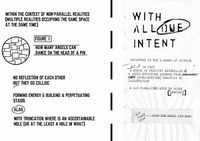 For this series, artist Lawrence Weiner made an artist’s book in exactly the same format (A6) and with the same number of pages (24) as his first contribution to documenta 5 in 1972, curated by Harald Szeemann. The partly handwritten instructions, statements, definitions, poems, and pictograms give an insight into his artistic practice and—as eloquently as poetically—transfer his ideas around dOCUMENTA (13) into language. -- Publisher's website.
For this series, artist Lawrence Weiner made an artist’s book in exactly the same format (A6) and with the same number of pages (24) as his first contribution to documenta 5 in 1972, curated by Harald Szeemann. The partly handwritten instructions, statements, definitions, poems, and pictograms give an insight into his artistic practice and—as eloquently as poetically—transfer his ideas around dOCUMENTA (13) into language. -- Publisher's website. -
 This work presents six neighborhoods examining the decline of biodiversity, the environment and the quality of our lives as we know it. Image and word bites illuminate the problems of population growth, ocean acidity and overfishing, deforestation, species extinction, disease, and climate change. Copyright-free 19th century engravings have been worked together in Photoshop to tell today’s stories and in a way, connect today’s problems with many of the same ones faced by those living when these engravings were originally created. Accompanying the neighborhoods are mini treatises adding specifics to the “greater than a thousand word images”. The titles are patterned after 19th century book titling practices. -- Distributor's website.
This work presents six neighborhoods examining the decline of biodiversity, the environment and the quality of our lives as we know it. Image and word bites illuminate the problems of population growth, ocean acidity and overfishing, deforestation, species extinction, disease, and climate change. Copyright-free 19th century engravings have been worked together in Photoshop to tell today’s stories and in a way, connect today’s problems with many of the same ones faced by those living when these engravings were originally created. Accompanying the neighborhoods are mini treatises adding specifics to the “greater than a thousand word images”. The titles are patterned after 19th century book titling practices. -- Distributor's website. -
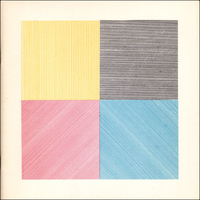
-
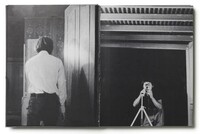
-
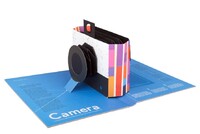 This is a working camera that lives in a pop-up book. The book concisely explains—while actively demonstrating—how a structure as humble as a folded piece of paper can tap into the intrinsic properties of light to produce a photograph. -- Artist's website.
This is a working camera that lives in a pop-up book. The book concisely explains—while actively demonstrating—how a structure as humble as a folded piece of paper can tap into the intrinsic properties of light to produce a photograph. -- Artist's website. -
 Visionaire 55: Surprise presents 12 hardcover pop-up books, boxed together, with projects by Steven Meisel, Mario Testino, Steven Klein, Sophie Calle, Andreas Gursky, Cai Guo-Qiang, Guido Mocafico, Sølve Sundsbø, Yayoi Kusama, Gareth Pugh and Alasdair McLellan adapted into three-dimensional paper sculptures by paper engineer Bruce Foster.
Visionaire 55: Surprise presents 12 hardcover pop-up books, boxed together, with projects by Steven Meisel, Mario Testino, Steven Klein, Sophie Calle, Andreas Gursky, Cai Guo-Qiang, Guido Mocafico, Sølve Sundsbø, Yayoi Kusama, Gareth Pugh and Alasdair McLellan adapted into three-dimensional paper sculptures by paper engineer Bruce Foster. -

-
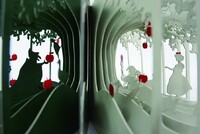 The 360°BOOK is a new revolutionary format that enables the artist to create a panoramic three-dimensional world. The book opens and expands into a dynamic circle of pages. Each page is finely crafted works of art, drawing the viewer from a scene of two dimensions to a three-dimensional world/diorama. -- Publisher's website.
The 360°BOOK is a new revolutionary format that enables the artist to create a panoramic three-dimensional world. The book opens and expands into a dynamic circle of pages. Each page is finely crafted works of art, drawing the viewer from a scene of two dimensions to a three-dimensional world/diorama. -- Publisher's website. -
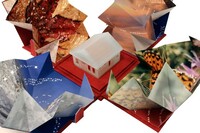 Finding Home is a visual narrative on being unsettled in an environment. I have moved many times during my lifetime but I still desire to be home—to find a sense of place, a sense of belonging. My new artists’ book Finding Home tackles the experience of living in Idaho while I’m still deeply rooted in Canada. Dissimilar environments between my home divided by miles and miles of where I live give rise to common elements: butterflies, snow, sunsets, and the Maple Leaf. Where I belong means more than the place I inhabit. The question remains—where do I belong? -- Artist's description.
Finding Home is a visual narrative on being unsettled in an environment. I have moved many times during my lifetime but I still desire to be home—to find a sense of place, a sense of belonging. My new artists’ book Finding Home tackles the experience of living in Idaho while I’m still deeply rooted in Canada. Dissimilar environments between my home divided by miles and miles of where I live give rise to common elements: butterflies, snow, sunsets, and the Maple Leaf. Where I belong means more than the place I inhabit. The question remains—where do I belong? -- Artist's description. -
 A book in the shape of a tetrahedron is pretty close to the general shape of a volcano. Primeval could be showcasing the earth millions of years ago, but is actually showing the current landscape. With a brief description of what happened in the massive 1980 eruption of Mt. St. Helens and overhead photos of the newly reformed landscape, in the aftermath of an earth changing event. Primeval unfolds to 4 panels, 3 foldouts, lots of photos, text about the eruption of Mt. St. Helens, a colophon, and a sampling of real ash from the volcano, bound with wire edge binding. -- Publisher's website.
A book in the shape of a tetrahedron is pretty close to the general shape of a volcano. Primeval could be showcasing the earth millions of years ago, but is actually showing the current landscape. With a brief description of what happened in the massive 1980 eruption of Mt. St. Helens and overhead photos of the newly reformed landscape, in the aftermath of an earth changing event. Primeval unfolds to 4 panels, 3 foldouts, lots of photos, text about the eruption of Mt. St. Helens, a colophon, and a sampling of real ash from the volcano, bound with wire edge binding. -- Publisher's website. -
 Drawing upon short personal statements and factual political texts, Necessary Disclosures investigates the relationship between the way we interact as individuals and the way we interact as nation-states. Questioning the rigidity of the categories “public” and “private,” the reader is asked to ponder similarities between events in one’s private life and those happening on a global scale. Spherical in form, the book opens to revel six nested “pages” of text that unstack to be read. -- Publisher's website.
Drawing upon short personal statements and factual political texts, Necessary Disclosures investigates the relationship between the way we interact as individuals and the way we interact as nation-states. Questioning the rigidity of the categories “public” and “private,” the reader is asked to ponder similarities between events in one’s private life and those happening on a global scale. Spherical in form, the book opens to revel six nested “pages” of text that unstack to be read. -- Publisher's website. -
 This book makes the link between cancer in women and the humanities: art therapy, philosophy, economics, technology, etc. The research on this disease is multidisciplinary and it involves all aspects that the patient and the team around him or her must face. For this book, I present six women and 6 different cancers that are pointed on the silhouettes. These women have next to them 6 "humanities" dresses that can help and perhaps protect them. The piece is made of two books intertwined thanks to a thread, a way to address the relationship between women and science. The books used are worn, this reminding patients who, despite their determination, often are weakened throughout the treatment. I used the collage on the cover: mammography portions of cells that are mixed here in artistic works. -- Artist's website.
This book makes the link between cancer in women and the humanities: art therapy, philosophy, economics, technology, etc. The research on this disease is multidisciplinary and it involves all aspects that the patient and the team around him or her must face. For this book, I present six women and 6 different cancers that are pointed on the silhouettes. These women have next to them 6 "humanities" dresses that can help and perhaps protect them. The piece is made of two books intertwined thanks to a thread, a way to address the relationship between women and science. The books used are worn, this reminding patients who, despite their determination, often are weakened throughout the treatment. I used the collage on the cover: mammography portions of cells that are mixed here in artistic works. -- Artist's website. -
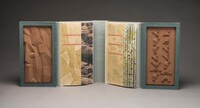 Wayfinding examines the relationship between physical and mental learning through the context of navigation through time and space. The first booklet focuses on the perspective of a physical learner and the second booklet is written from the perspective of a mental learner. When the book is opened to the second layer of trays and panels, the translation of an alphabet from gesture to symbol to three-dimensional abstract shapes is revealed, giving the reader the tools needed to decipher some of the abstract elements found throughout the book. The piece focuses the reader's experience on the physicality of the book as object through the inclusion of 3-dimensional cast paper sheets and pages of handmade paper that rattle when turned. A 3-dimensional alphabet abstracted from diagrams of flag semaphore addresses the activities of signaling and translation, and how information is taken in by all the senses and not just through the eyes. -- Artist statement.
Wayfinding examines the relationship between physical and mental learning through the context of navigation through time and space. The first booklet focuses on the perspective of a physical learner and the second booklet is written from the perspective of a mental learner. When the book is opened to the second layer of trays and panels, the translation of an alphabet from gesture to symbol to three-dimensional abstract shapes is revealed, giving the reader the tools needed to decipher some of the abstract elements found throughout the book. The piece focuses the reader's experience on the physicality of the book as object through the inclusion of 3-dimensional cast paper sheets and pages of handmade paper that rattle when turned. A 3-dimensional alphabet abstracted from diagrams of flag semaphore addresses the activities of signaling and translation, and how information is taken in by all the senses and not just through the eyes. -- Artist statement. -
 "I constructed a three-dimensional structure that turns and eddies on itself while embodying a visual tale. Like a book, the structure opens to allow a linear reading of the photographs and texts." -- Artist's note on the distributor's website.
"I constructed a three-dimensional structure that turns and eddies on itself while embodying a visual tale. Like a book, the structure opens to allow a linear reading of the photographs and texts." -- Artist's note on the distributor's website. -
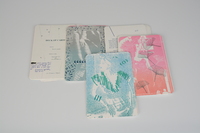 Deck of Cards is 52 'cards' constituting a textual and visual description of a single spring moment in Pittsburgh. The 'cards' are 'readable' in any order and should be shuffled before each reading. The narrative operates in the interactive present- the present because the 'now' is the only form of time in which action occurs with an unknown outcome; interactive because the reader, by rearranging the sequence of the text, involves in the creation of the narrative. From a narrative perspective the 'past' or 'future' lack one of those attributes- the narrative outcome must be known or it must be predetermined. Deck of Cards, involving the reader as co-author of the text, seeks also to participate the reader in the narrative as one of the characters experiencing the described events. These events are treated as occurring simultaneously in the lives of five characters: at the moment Julie steps on board her bus, Paul is already almost downtown on an earlier bus; Richard is awakening; Enid is visiting her psychiatrist and Dora is getting dressed. Because the 'real time' are simultaneous, the order of presentation is irrelevant. The characters, however recall their interlocked pasts with recollections developing a 'plot' leading to the described moment. The order of the immediate and recollected experiences is determined by the reader who, having shuffled the 'cards', has created a text which only that reader has made. -- Author's note.
Deck of Cards is 52 'cards' constituting a textual and visual description of a single spring moment in Pittsburgh. The 'cards' are 'readable' in any order and should be shuffled before each reading. The narrative operates in the interactive present- the present because the 'now' is the only form of time in which action occurs with an unknown outcome; interactive because the reader, by rearranging the sequence of the text, involves in the creation of the narrative. From a narrative perspective the 'past' or 'future' lack one of those attributes- the narrative outcome must be known or it must be predetermined. Deck of Cards, involving the reader as co-author of the text, seeks also to participate the reader in the narrative as one of the characters experiencing the described events. These events are treated as occurring simultaneously in the lives of five characters: at the moment Julie steps on board her bus, Paul is already almost downtown on an earlier bus; Richard is awakening; Enid is visiting her psychiatrist and Dora is getting dressed. Because the 'real time' are simultaneous, the order of presentation is irrelevant. The characters, however recall their interlocked pasts with recollections developing a 'plot' leading to the described moment. The order of the immediate and recollected experiences is determined by the reader who, having shuffled the 'cards', has created a text which only that reader has made. -- Author's note. -
 This work consists of a pair of anonymous male images: "Brutus" and "Caesar" that are bisected by a different potential murder weapon on every page.
This work consists of a pair of anonymous male images: "Brutus" and "Caesar" that are bisected by a different potential murder weapon on every page. -
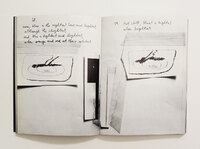
-
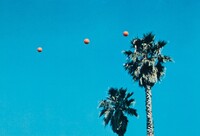 Baldessari threw three balls at once, trying to line them up in midair, while his then-wife, Carol Wixom, took pictures. Baldessari made thirty-six attempts—the number of exposures on a standard 35 mm film roll—and chose the twelve shots he considered most successful.
Baldessari threw three balls at once, trying to line them up in midair, while his then-wife, Carol Wixom, took pictures. Baldessari made thirty-six attempts—the number of exposures on a standard 35 mm film roll—and chose the twelve shots he considered most successful. -
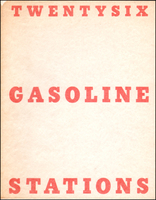 Considered seminal in the history of artist books, this work consists of black and white photographs of gas stations taken along route 66 between Los Angeles and Oklahoma City.
Considered seminal in the history of artist books, this work consists of black and white photographs of gas stations taken along route 66 between Los Angeles and Oklahoma City. -
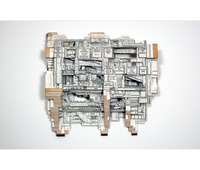 Brian Dettmer creates sculpture from books by sealing the edges, then dissecting them from the front with knives and tweezers to expose ideas and areas of interest.
Brian Dettmer creates sculpture from books by sealing the edges, then dissecting them from the front with knives and tweezers to expose ideas and areas of interest. -
 The apple is made from random pages ripped from a decaying dictionary and adhered to a Styrofoam core. The 'excelsior' packaging inside the crate is coated with PVA/starch mix, cut and curled from "A" pages of an antique dictionary, including the pages listing hereditary apple varieties. The apple is recurring theme in both European mythology and Christian history: a long time embodiment of both learning and danger, sometimes it is just as simple as an apple for the teacher. -- Artist's statement.
The apple is made from random pages ripped from a decaying dictionary and adhered to a Styrofoam core. The 'excelsior' packaging inside the crate is coated with PVA/starch mix, cut and curled from "A" pages of an antique dictionary, including the pages listing hereditary apple varieties. The apple is recurring theme in both European mythology and Christian history: a long time embodiment of both learning and danger, sometimes it is just as simple as an apple for the teacher. -- Artist's statement. -
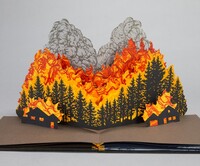 YOU Cannot Put a Fire Out addresses Earth’s current and increasing climate instability due to our use of fossil fuels, against the thought that ultimately we are defenseless against powerful natural forces. 2018 was the deadliest and most destructive wildfire season in California history. The “Camp Fire” destroyed the town of Paradise in Northern California on November 8, 2108. The 2018 Atlantic hurricane season was the third in a consecutive series of above average and damaging Atlantic hurricane seasons, featuring fifteen named storms, eight hurricanes, and two major hurricanes. On September 5, Florence became the first major hurricane of the season. Woodcut images are modeled after the wildfire in Paradise and Hurricane Florence. -- Artist's website.
YOU Cannot Put a Fire Out addresses Earth’s current and increasing climate instability due to our use of fossil fuels, against the thought that ultimately we are defenseless against powerful natural forces. 2018 was the deadliest and most destructive wildfire season in California history. The “Camp Fire” destroyed the town of Paradise in Northern California on November 8, 2108. The 2018 Atlantic hurricane season was the third in a consecutive series of above average and damaging Atlantic hurricane seasons, featuring fifteen named storms, eight hurricanes, and two major hurricanes. On September 5, Florence became the first major hurricane of the season. Woodcut images are modeled after the wildfire in Paradise and Hurricane Florence. -- Artist's website. -
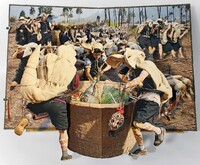 Yi people worship the tiger as their grandest totem. As the ancestor of humans, the Tiger is the creator of heaven, earth, and all creatures. Upon a Yi person's last breath their soul transforms into a tiger. The Yi people from Southeast Chuxiong (a Yi Autonomous Prefecture) believe that they once lived in a mystical forest disturbed by serpents and wild beasts. Annually, under the direction of the black Tiger King, they offer sacrifices and dance to reflect the journey and way of life of the Yi people. Yi men dress up in felted tiger costumes and visit each house to guard the village from evils. They dance - mimicking surveying, plowing, harrowing, sowing, and weeding - all steps of the rice-growing cycle, to ensure a healthy crop and long life for all. Thus ‘Luoma’, the Tiger Festival, was created to protect the village and display the Yi people's tiger-like strength and valor. -- Artist's statement.
Yi people worship the tiger as their grandest totem. As the ancestor of humans, the Tiger is the creator of heaven, earth, and all creatures. Upon a Yi person's last breath their soul transforms into a tiger. The Yi people from Southeast Chuxiong (a Yi Autonomous Prefecture) believe that they once lived in a mystical forest disturbed by serpents and wild beasts. Annually, under the direction of the black Tiger King, they offer sacrifices and dance to reflect the journey and way of life of the Yi people. Yi men dress up in felted tiger costumes and visit each house to guard the village from evils. They dance - mimicking surveying, plowing, harrowing, sowing, and weeding - all steps of the rice-growing cycle, to ensure a healthy crop and long life for all. Thus ‘Luoma’, the Tiger Festival, was created to protect the village and display the Yi people's tiger-like strength and valor. -- Artist's statement. -
